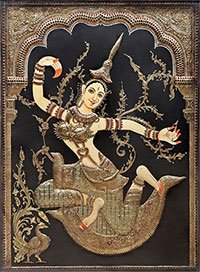Shasya, Śasya, Sasya, Śāsya, Shashya: 20 definitions
Introduction:
Shasya means something in Buddhism, Pali, Hinduism, Sanskrit, Marathi, Hindi. If you want to know the exact meaning, history, etymology or English translation of this term then check out the descriptions on this page. Add your comment or reference to a book if you want to contribute to this summary article.
The Sanskrit terms Śasya and Śāsya can be transliterated into English as Sasya or Shasya, using the IAST transliteration scheme (?).
Alternative spellings of this word include Shasy.
In Hinduism
Purana and Itihasa (epic history)
Source: archive.org: Nilamata Purana: a cultural and literary studySasya (सस्य) represents all cereals and pulses, forming part of a common diet in ancient Kashmir (Kaśmīra) as mentioned in the Nīlamatapurāṇa.—Most of the references to the articles of diet occur in the Nīlamata in connection with the offerings made to the gods but it is not difficult to infer from them the food and drink of the common people because “what a man eats his gods eat”.

The Purana (पुराण, purāṇas) refers to Sanskrit literature preserving ancient India’s vast cultural history, including historical legends, religious ceremonies, various arts and sciences. The eighteen mahapuranas total over 400,000 shlokas (metrical couplets) and date to at least several centuries BCE.
Ayurveda (science of life)
Nighantu (Synonyms and Characteristics of Drugs and technical terms)
Source: Wisdom Library: Raj NighantuŚasya (शस्य) refers to the “fruit” of a tree, according to the second chapter (dharaṇyādi-varga) of the 13th-century Raj Nighantu or Rājanighaṇṭu (an Ayurvedic encyclopedia). The Dharaṇyādi-varga covers the lands, soil, mountains, jungles and vegetation’s relations between trees [viz., Śasya] and plants and substances, with their various kinds.
Note: the fruit product of any tree/herb or shrub is only known as Śasya, till it is in the field.

Āyurveda (आयुर्वेद, ayurveda) is a branch of Indian science dealing with medicine, herbalism, taxology, anatomy, surgery, alchemy and related topics. Traditional practice of Āyurveda in ancient India dates back to at least the first millenium BC. Literature is commonly written in Sanskrit using various poetic metres.
Dharmashastra (religious law)
Source: Sacred Texts: The Grihya Sutras, Part 2 (SBE30)Śasya (शस्य) refers to “corn in the field”.—The taṇḍulas are the unhusked grains, piṣṭa is the ground flour. In Sanskrit a distinction is made between śasya, the corn in the field, dhānya, corn with the husk, taṇḍula, grains without husks, anna, roasted grains.

Dharmashastra (धर्मशास्त्र, dharmaśāstra) contains the instructions (shastra) regarding religious conduct of livelihood (dharma), ceremonies, jurisprudence (study of law) and more. It is categorized as smriti, an important and authoritative selection of books dealing with the Hindu lifestyle.
Jyotisha (astronomy and astrology)
Source: Wisdom Library: Brihat Samhita by VarahamihiraSasya (सस्य) refers to an “crops” (i.e., harvest), according to the Bṛhatsaṃhitā (chapter 3), an encyclopedic Sanskrit work written by Varāhamihira mainly focusing on the science of ancient Indian astronomy astronomy (Jyotiṣa).—Accordingly, “Either from observing some distant point in the horizon where the sun rises or sets or from observing the ingress or the egress of the end of shadow of a perpendicular rod placed at the centre of a big horizontal circle (the change in the sun’s course can be detected). [...] The Sun when he changes his course from north to south and when in his usual condition will bring on prosperity and increase of crops [i.e., kṣema-sasya-vṛddhi-kara]; but when he undergoes a change either in his usual course or in his usual appearance he causes fear to mankind”.

Jyotisha (ज्योतिष, jyotiṣa or jyotish) refers to ‘astronomy’ or “Vedic astrology” and represents the fifth of the six Vedangas (additional sciences to be studied along with the Vedas). Jyotisha concerns itself with the study and prediction of the movements of celestial bodies, in order to calculate the auspicious time for rituals and ceremonies.
Sports, Arts and Entertainment (wordly enjoyments)
Source: archive.org: Syainika Sastra of Rudradeva with English Translation (art)Śasya (शस्य) refers to the “standing crop” (protected by hunters), according to the Śyainika-śāstra: a Sanskrit treatise dealing with the divisions and benefits of Hunting and Hawking, written by Rājā Rudradeva (or Candradeva) in possibly the 13th century.—Accordingly, “Hunting on horseback (āśvina) represents one of the eight subdivisions of Hunting (mṛgayā). [...] It leads to the acquisition of religious merit, by killing ferocious animals such as wolves and tigers, by the protection of standing crop (śasya), by the slaughter of stags and other animals, by an inspection of the forest, which serves so many useful purposes, by frightening the thieves, and by conciliating forest tribes. [...]”.

This section covers the skills and profiencies of the Kalas (“performing arts”) and Shastras (“sciences”) involving ancient Indian traditions of sports, games, arts, entertainment, love-making and other means of wordly enjoyments. Traditionally these topics were dealt with in Sanskrit treatises explaing the philosophy and the justification of enjoying the pleasures of the senses.
In Buddhism
Tibetan Buddhism (Vajrayana or tantric Buddhism)
Source: Bibliotheca Polyglotta: Ratnagotravibhāga (Uttaratantra)Sasya (सस्य) refers to “harvest”, according to the 3rd-century Ratnagotravibhāga (Uttaratantra) verse 4.42-43.—“[...] it is said that [the mind of the Buddha in its activity] is like a cloud (megha). Just as, in the rainy season, the clouds discharge, without any effort, The multitudes of water on the earth, Causing abundance of harvest (sasya-sampad); In a similar manner, the Buddha Discharges the rain of the Highest Doctrine From the clouds of Compassion, with no searching thought, For [bringing] the crops of virtue among the living beings”.
Source: Brill: Śaivism and the Tantric Traditions (tantric Buddhism)Śasya (शस्य) refers to the “crop (that is the fourth state of consciousness)”, according to Vāgīśvarakīrti’s Tattvaratnāvaloka verse 17.—Accordingly, “Cleansed by the oozing of the seed (i.e. semen) from the thunderbolt (i.e.the officiant’s penis) growing as a sprout born from a purified lotus (i.e. the consecrated vulva of the consort), the crop that is the fourth [state of consciousness] (turīya-śasya) comes to full bloom; [although] the Fourth [Initiation] is manifest, it is hidden even from the wise”.

Tibetan Buddhism includes schools such as Nyingma, Kadampa, Kagyu and Gelug. Their primary canon of literature is divided in two broad categories: The Kangyur, which consists of Buddha’s words, and the Tengyur, which includes commentaries from various sources. Esotericism and tantra techniques (vajrayāna) are collected indepently.
Languages of India and abroad
Marathi-English dictionary
Source: DDSA: The Molesworth Marathi and English Dictionaryśāsya (शास्य).—a S (Possible, purposed, necessary &c.) to be punished or corrected; also to be regulated or ordained; to be provided for by an act of government or of judicature.
--- OR ---
sasya (सस्य).—n S Fruit in general: but understood esp, of corn or grain.
Source: DDSA: The Aryabhusan school dictionary, Marathi-Englishsasya (सस्य).—n Fruit in general; corn or grain.
Marathi is an Indo-European language having over 70 million native speakers people in (predominantly) Maharashtra India. Marathi, like many other Indo-Aryan languages, evolved from early forms of Prakrit, which itself is a subset of Sanskrit, one of the most ancient languages of the world.
Sanskrit dictionary
Source: DDSA: The practical Sanskrit-English dictionaryŚasya (शस्य).—[śas-yat]
1) Corn or grain in general; दुदोह गां स यज्ञाय शस्याय मघवा दिवम् (dudoha gāṃ sa yajñāya śasyāya maghavā divam) R.1.26.
2) The produce or fruit of a plant or tree; शस्यं क्षेत्रगतं प्राहुः सतुषं धान्यमुच्यते (śasyaṃ kṣetragataṃ prāhuḥ satuṣaṃ dhānyamucyate); see तण्डुल (taṇḍula) also.
3) A merit.
Derivable forms: śasyam (शस्यम्).
--- OR ---
Śāsya (शास्य).—a. [śās-ṇyat]
1) To be taught or advised.
2) To be regulated or governed.
3) Deserving punishment, punishable.
--- OR ---
Sasya (सस्य).—[sas-yat Uṇādi-sūtra 4.119]
1) Corn, grain; (etāni) सस्यैः पूर्णे जठरपिठरे प्राणिनां संभवन्ति (sasyaiḥ pūrṇe jaṭharapiṭhare prāṇināṃ saṃbhavanti) Pañcatantra (Bombay) 5.97; see शस्य (śasya) also.
2) Fruit or produce of any plant.
3) A weapon.
4) A good quality, merit.
Derivable forms: sasyam (सस्यम्).
Source: Cologne Digital Sanskrit Dictionaries: Shabda-Sagara Sanskrit-English DictionaryŚasya (शस्य).—mfn.
(-syaḥ-syā-syaṃ) 1. Excellent, best. 2. To be hurt or injured. 3. Desirable, to be wished. n.
(-syaṃ) 1. Fruit. 2. Corn, grain in general. 3. Good quantity, merit. 4. Grass. E. śas to hurt, aff. yat; or śasi to wish, kyap aff.
--- OR ---
Śāsya (शास्य).—mfn.
(-syaḥ-syā-syaṃ) 1. To be regulated or ordained, to be enforced, to be provided for by any act of government or judicature. 2. To be advised. 3. Punishable, deserving punishment. E. śās to govern, aff. ṇyat .
--- OR ---
Sasya (सस्य).—n.
(-syaṃ) 1. Fruit. 2. Corn, grain. 3. A weapon. 4. A quality, an excellence. E. sas to sleep, yat Unadi aff; also śasya, &c.
Source: Cologne Digital Sanskrit Dictionaries: Benfey Sanskrit-English DictionaryŚasya (शस्य).—see śaṃs.
--- OR ---
Sasya (सस्य).—n. 1. Fruit, [Nala] 24, 52 (at the end of a comp. adj., f. yā). 2. Corn, grain, [Mānavadharmaśāstra] 4, 26 (cf. śasya, under śaṃs). 3. A weapon (cf. śas). 4. A quality, an excellence (cf. śaṃs).
— Cf. perhaps .
Source: Cologne Digital Sanskrit Dictionaries: Cappeller Sanskrit-English DictionaryŚasya (शस्य).—[adjective] to be recited or praised; [neuter] recitation.
--- OR ---
Śāsya (शास्य).—[adjective] to be punished, directed, or ruled.
--- OR ---
Sasya (सस्य).—[neuter] standing crop, produce of the field, seed, grain, fruit; poss. vant†.
Source: Cologne Digital Sanskrit Dictionaries: Monier-Williams Sanskrit-English Dictionary1) Śasya (शस्य):—[from śaṃs] 1. śasya mfn. (for 2. See p. 1061, col. 2) to be recited or treated as a Śastra, [Brāhmaṇa]
2) [v.s. ...] to be praised or celebrated, [Kāvya literature]
3) [v.s. ...] to be wished, desirable, excellent, [Horace H. Wilson]
4) [v.s. ...] n. recitation, [Śāṅkhāyana-brāhmaṇa]
5) [v.s. ...] good quality, merit, [Horace H. Wilson]
6) [from śas] 2. śasya mfn. to be cut down or slaughtered or killed, [Vopadeva]
7) [v.s. ...] n. corn, grain (more correctly sasya q.v.)
8) Śāsya (शास्य):—[from śās] mfn. to be punished, punishable, [Manu-smṛti; Gautama-dharma-śāstra; Bālarāmāyaṇa]
9) [v.s. ...] to be controlled or governed, [Mahābhārata]
10) [v.s. ...] to be directed, [Ṛg-veda]
11) [v.s. ...] to be corrected, [Monier-Williams’ Sanskrit-English Dictionary]
12) [v.s. ...] [wrong reading] for sasya, [Mahābhārata xii, 2691.]
13) Sasya (सस्य):—1. sasya n. (of unknown derivation; also written śasya; ifc. f(ā). ) corn, grain, fruit, a crop of corn (also [plural]), [Atharva-veda]; etc.
14) 2. sasya m. (perhaps incorrect for śasya) a sort of precious stone, [cf. Lexicographers, esp. such as amarasiṃha, halāyudha, hemacandra, etc.]
15) n. a weapon, [cf. Lexicographers, esp. such as amarasiṃha, halāyudha, hemacandra, etc.]
16) virtue, merit, [cf. Lexicographers, esp. such as amarasiṃha, halāyudha, hemacandra, etc.]
Source: Cologne Digital Sanskrit Dictionaries: Yates Sanskrit-English Dictionary1) Śasya (शस्य):—(syaṃ) 1. n. Fruit; corn; good quality, merit. a. Excellent; injured; desirable.
2) śūka (kaṃ) 1. n. Beard of corn.
3) Śāsya (शास्य):—[(syaḥ-syā-syaṃ) a.] That may or should be regulated, ordained, or punished.
4) Sasya (सस्य):—(syaṃ) 1. n. Fruit, corn, grain; a weapon; excellence.
Source: DDSA: Paia-sadda-mahannavo; a comprehensive Prakrit Hindi dictionary (S)Śasya (शस्य) in the Sanskrit language is related to the Prakrit words: Sassa, Sāsa.
[Sanskrit to German]
Sanskrit, also spelled संस्कृतम् (saṃskṛtam), is an ancient language of India commonly seen as the grandmother of the Indo-European language family (even English!). Closely allied with Prakrit and Pali, Sanskrit is more exhaustive in both grammar and terms and has the most extensive collection of literature in the world, greatly surpassing its sister-languages Greek and Latin.
Hindi dictionary
Source: DDSA: A practical Hindi-English dictionary1) Śasya (शस्य) [Also spelled shasy]:—(nm) see [sasya].
2) Sasya (सस्य):—(nm) crop; -[krāṃti] green revolution; ~[pāla] a field-guard; ~[śāli] full of corn; —[śyāmalā] lush green and cropwise rich.
...
Kannada-English dictionary
Source: Alar: Kannada-English corpusŚasya (ಶಸ್ಯ):—
1) [adjective] told; uttered; spoken.
2) [adjective] fit to be praised; praiseworthy.
3) [adjective] good; excellent.
4) [adjective] cut; split; divided; cleft.
5) [adjective] killed, slaughtered.
--- OR ---
Śasya (ಶಸ್ಯ):—
1) [noun] '[rightly ಸಸ್ಯ [sasya]] corn; grain.'2) [noun] any agricultural produce.
--- OR ---
Śasya (ಶಸ್ಯ):—[noun] a kind of gem.
--- OR ---
Sasya (ಸಸ್ಯ):—
1) [noun] a tiny, hard particle, as of salt or sand; a granule; a grain.
2) [noun] the edible plant structure of a mature ovary of a flowering plant, usu. eaten raw; a fruit.
3) [noun] any of a kingdom Plantae, as creepers, tree, shrub, herb etc.; a plant.
4) [noun] a class that is superior to others in quality, merit, etc.
5) [noun] a kind of gem.
Kannada is a Dravidian language (as opposed to the Indo-European language family) mainly spoken in the southwestern region of India.
Nepali dictionary
Source: unoes: Nepali-English Dictionary1) Śasya (शस्य):—adj. praiseworthy; laudable; admirable; commendable; n. 1. corn; grain; 2. agricultural produce;
2) Sasya (सस्य):—n. 1. crop; grain; 2. paddy; 3. fruit of produce of any plant;
Nepali is the primary language of the Nepalese people counting almost 20 million native speakers. The country of Nepal is situated in the Himalaya mountain range to the north of India.
See also (Relevant definitions)
Starts with: Sasyaka, Shasyabhakshaka, Shasyabhakshana, Shasyabhumi, Shasyadhvamsin, Shasyakshetra, Shasyam, Shasyamalin, Shasyamanjari, Shasyarakshaka, Shasyaru, Shasyasambara, Shasyasampad, Shasyasampanna, Shasyashalin, Shasyashuka, Shasyaspanda.
Ends with (+17): Abhishasya, Adashasya, Adhyanushasya, Anashasya, Anuptashasya, Anushasya, Aprashasya, Arakshasya, Ashasya, Aushasya, Ayashasya, Dashasya, Doshasya, Dvadashasya, Jatishasya, Meshasya, Mokshada shukla margashirshasya, Narikelashasya, Navashasya, Pacchahshasya.
Full-text (+117): Shasyamanjari, Shasyakshetra, Shasyarakshaka, Sasyasamvara, Navashasya, Jatishasya, Shasyashuka, Shasyabhakshaka, Pancasasya, Sasyeshti, Shasyamalin, Shasyam, Tandula, Shasyabhakshana, Sasyam, Sasyaveda, Shasyasambara, Yavashasya, Sasyaprada, Purvasasya.
Relevant text
Search found 12 books and stories containing Shasya, Śasya, Sasya, Śāsya, Shashya, Śaṣya; (plurals include: Shasyas, Śasyas, Sasyas, Śāsyas, Shashyas, Śaṣyas). You can also click to the full overview containing English textual excerpts. Below are direct links for the most relevant articles:
Shishupala-vadha (Study) (by Shila Chakraborty)
Proper time for war < [Chapter 6 - Principles of Warfare]
Marching time (towards the enemy) < [Chapter 1 - Concept of Vijigīṣu king]
Saṃśraya (seeking protection) < [Chapter 3 - Six fold policies of a king (Ṣāḍguṇya)]
Rig Veda (translation and commentary) (by H. H. Wilson)
Manusmriti with the Commentary of Medhatithi (by Ganganatha Jha)
Verse 4.164 < [Section XIV - Other Duties]
Verse 2.159 < [Section XXVI - Chastisement of Pupils]
Verse 7.67-69 < [Section V - The Ambassador (dūta)]
Gobhila-grihya-sutra (by Hermann Oldenberg)
The Markandeya Purana (by Frederick Eden Pargiter)
Brihat Samhita (by N. Chidambaram Iyer)